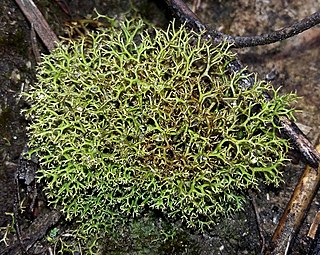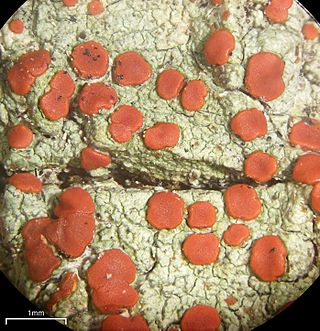
Cladia is a genus of lichenized fungi in the family Cladoniaceae. Cladia species have a crustose primary thallus and a fruticose, secondary thallus, often referred to as pseudopodetium. The type species of the genus, Cladia aggregata, is widely distributed, occurring from South America, South Africa, Australasia and South-East Asia to southern Japan and India. Most of the other species are found in the Southern Hemisphere.
Kantvilasia is a lichen genus in the family Pilocarpaceae. This is a monotypic genus, containing the single species Kantvilasia hians.
Japewiella is a genus of lichen in the family Lecanoraceae. It was circumscribed in 2000 by German botanist and lichenologist Christian Printzen as a segregate of the genus Japewia. The genus name of Japewia was in honour of Peter Wilfrid James, who was an English botanist. The genus was circumscribed by Christian Printzen in Bryologist vol.102 on page 715 in 1999.

Lecidella is a genus of crustose lichens in the family Lecanoraceae.

Ramboldia is a genus of lichen-forming fungi in the family Ramboldiaceae. The genus was circumscribed in 1994 by Gintaras Kantvilas and John Alan Elix. It was emended in 2008 by the inclusion of Pyrrhospora species containing the anthraquinone russulone in their apothecia and having a prosoplectenchymatous exciple. The family Ramboldiaceae was circumscribed in 2014 to contain the genus.

Rhizocarpon is a genus of crustose, saxicolous, lecideoid lichens in the family Rhizocarpaceae. The genus is common in arctic-alpine environments, but also occurs throughout temperate, subtropical, and even tropical regions. They are commonly known as map lichens because of the prothallus forming border-like bands between colonies in some species, like the common map lichen.
Menegazzia minuta is a rare species of foliose lichen that is endemic to Tasmania, Australia. It was scientifically described as a new species in 1987 by lichenologists Peter James and Gintaras Kantvilas. The type specimen was collected by the second author south of Arthur River, where the lichen was found in a rainforest growing on twigs of leatherwood. The species epithet minuta refers to the small size of its thallus. Menegazzia minuta contains protolichesterinic acid, a lichen product that helps to distinguish it from the similar species Menegazzia eperforata, which instead contains stictic acid and related compounds. In a 2012 publication, Kantvilas called M. minuta "one of Tasmania's rarest lichens", characterised by a "glossy olive-brown thallus of minute, spidery lobes, densely beset with lobule-like isidia".
Tasmidella is a lichen genus in the family Ramalinaceae. Circumscribed by Gintaras Kantvilas, Josef Hafellner, and John A. Elix in 1999, it contains the single species Tasmidella variabilis, found in Tasmania. It is distinguished from the closely related genus Megalaria by having simple spores with a layered wall.

Mycoblastus is a genus of crustose lichens in the family Tephromelataceae. Members of the genus are commonly called blood lichens.
Gintaras Kantvilas is an Australian lichenologist, who earned his Ph.D in 1985 from the University of Tasmania with a thesis entitled Studies on Tasmanian rainforest lichens. He has authored over 432 species names, and 167 genera in the field of mycology.
Amandinea devilliersiana is a species of crustose lichen in the family Caliciaceae, and found in South Australia. It was first described in 2013 by Australian lichenologists Jack Elix and Gintaras Kantvilas from a specimen collected on a granite boulder near the seashore in South Australia. The species epithet, devilliersiana, honours Brigitte de Villiers. Specimens used for the description came from both Tasmania and South Australia.
Punctelia transtasmanica is a species of foliose lichen in the family Parmeliaceae. It is found in Australasia.
Punctelia pseudocoralloidea is a species of foliose lichen in the family Parmeliaceae. It is found in Australia, where it grows on bark and on wood.

Megalospora is a genus of lichen-forming fungi in the family Megalosporaceae.
Menegazzia abscondita is a species of foliose lichen in the family Parmeliaceae. Found in Australasia, the species was described as new to science by Australian lichenologist Gintaras Kantvilas in 2012. The type specimen was collected along Gordon River Road in Tasmania at an altitude of 340 m (1,120 ft). Here it was found growing on satinwood at the edge of a wet eucalypt forest. The specific epithet abscondita means "hidden", and refers to "the effort required to collect sufficient material upon which to base its description".
Menegazzia athrotaxidis is a species of foliose lichen in the family Parmeliaceae. Found in Australia, the species was described as new to science by Australian lichenologist Gintaras Kantvilas in 2012. The type specimen was collected in Mount Field National Park, southeast of Lake Emmett. Here it was found at an altitude of 980 m (3,220 ft), where it was growing on the bark of pencil pine in a mountainous rainforest. The specific epithet refers to the genus of its host. The lichen is only known to occur in the highlands of Tasmania, where it mostly grows on conifers.
Menegazzia hypogymnioides is a species of foliose lichen in the family Parmeliaceae. Found in Australia, the species was described as new to science by Australian lichenologist Gintaras Kantvilas in 2012. The type specimen was collected from Clear Hill, Tasmania, at an altitude of 1,190 m (3,900 ft), where it was growing on conglomerate boulders in alpine heath. The specific epithet refers to its similarity to a small species of Hypogymnia. It is a very rare species that occurs only at high elevations in southwestern Tasmania, typically in sheltered habitats.
Menegazzia petraea is a rare species of foliose lichen in the family Parmeliaceae. Found in Australia, the species was described as new to science by Australian lichenologist Gintaras Kantvilas in 2012. The type specimen was collected at the summit of Gog Range, Tasmania at an altitude of 720 m (2,360 ft). Here it was found growing on conglomerate boulders in scrubby heath. The specific epithet petraea not only refers to its saxicolous habitat, but also indirectly hints at the first name of English botanist and lichenologist Peter Wilfred James, who, according to Kantvilas, "has made significant contributions to the study of Menegazzia and first noted the unusual chemical composition of this species".
Pseudocyphellaria brattii is a species of foliose lichen in the family Peltigeraceae. It was described as new to science in 1997 by lichenologists David John Galloway and Gintaras Kantvilas. The type specimen was collected along Mt. Dundas Track (Tasmania), where it was found growing on dead wood in a rainforest at an altitude of 700 m (2,300 ft). The specific epithet honours Tasmanian lichenologist Geoffrey Charles Bratt, who, according to the authors, "helped to keep Australian lichenology alive during the 'lean years'".
Lecanora helmutii is a rare species of corticolous (bark-dwelling), crustose lichen in the family Lecanoraceae. Found in Tasmania, it was formally described as a new species in 2018 by Sergio Pérez-Ortega and Gintaras Kantvilas. The type specimen was collected from the eastern side of Stanley Highway, where it was found growing on the bark of Banksia marginata in a coastal swampy woodland dominated by Melaleuca. It is only known from the type collection. Other associated lichens include Austroparmelina pseudorelicina, Bactropsora paludicola, Menegazzia subpertusa, Pannaria elixii, and Parmotrema perlatum. The species epithet honours Austrian lichenologist Helmut Mayrhofer.





